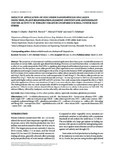Impact of application of zinc oxide nanoparticles on callus induction, plant regeneration, element content and antioxidant enzyme activity in tomato (Solanum lycopersicum MILL) under salt stress
| dc.contributor.author | Alharby, HF | |
| dc.contributor.author | Metwali, EMR | |
| dc.contributor.author | Fuller, MP | |
| dc.contributor.author | Aldhebiani, AY | |
| dc.date.accessioned | 2017-01-12T15:48:56Z | |
| dc.date.available | 2017-01-12T15:48:56Z | |
| dc.date.issued | 2017-03-21 | |
| dc.identifier.issn | 0354-4664 | |
| dc.identifier.issn | 1821-4339 | |
| dc.identifier.uri | http://hdl.handle.net/10026.1/8238 | |
| dc.description.abstract |
<jats:p>The properties of nanomaterials and their potential applications have been given considerable attention by researchers in various fields, especially agricultural biotechnology. However, not much has been done to evaluate the role or effect of zinc oxide nanoparticles (ZnO-NP) in regulating physiological and biochemical processes in response to salt-induced stress. For this purpose, some callus growth traits, plant regeneration rate, mineral element (sodium, potassium, phosphorous and nitrogen) contents and changes in the activity of superoxide dismutase (SOD) and glutathione peroxidase (GPX) in tissues of five tomato cultivars were investigated in a callus culture exposed to elevated concentrations of salt (3.0 and 6.0 g L-1NaCl), and in the presence of zinc oxide nanoparticles (15 and 30 mg L-1). The relative callus growth rate was inhibited by 3.0 g L-1 NaCl; this was increased dramatically at 6.0 g L-1. Increasing exposure to NaCl was associated with a significantly higher sodium content and SOD and GPX activities. Zinc oxide nanoparticles mitigated the effects of NaCl, and in this application of lower concentrations (15 mg L-1) was more effective than a higher concentration (30 mg L-1). This finding indicates that zinc oxide nanoparticles should be investigated further as a potential anti-stress agent in crop production. Different tomato cultivars showed different degrees of tolerance to salinity in the presence of ZnO-NP. The cultivars Edkawy, followed by Sandpoint, were less affected by salt stress than the cultivar Anna Aasa.</jats:p> | |
| dc.format.extent | 723-735 | |
| dc.language | en | |
| dc.language.iso | en | |
| dc.publisher | National Library of Serbia | |
| dc.subject | Nano biotechnology | |
| dc.subject | in vitro culture | |
| dc.subject | protein | |
| dc.subject | salinity | |
| dc.subject | superoxide dismutase | |
| dc.subject | glutathione peroxidase | |
| dc.title | Impact of application of zinc oxide nanoparticles on callus induction, plant regeneration, element content and antioxidant enzyme activity in tomato (Solanum lycopersicum MILL) under salt stress | |
| dc.type | journal-article | |
| dc.type | Journal Article | |
| plymouth.author-url | https://www.webofscience.com/api/gateway?GWVersion=2&SrcApp=PARTNER_APP&SrcAuth=LinksAMR&KeyUT=WOS:000389771500003&DestLinkType=FullRecord&DestApp=ALL_WOS&UsrCustomerID=11bb513d99f797142bcfeffcc58ea008 | |
| plymouth.issue | 4 | |
| plymouth.volume | 68 | |
| plymouth.publication-status | Published | |
| plymouth.journal | Archives of Biological Science | |
| dc.identifier.doi | 10.2298/ABS151105017A | |
| plymouth.organisational-group | /Plymouth | |
| plymouth.organisational-group | /Plymouth/Faculty of Science and Engineering | |
| plymouth.organisational-group | /Plymouth/Faculty of Science and Engineering/School of Biological and Marine Sciences | |
| plymouth.organisational-group | /Plymouth/REF 2021 Researchers by UoA | |
| plymouth.organisational-group | /Plymouth/REF 2021 Researchers by UoA/UoA06 Agriculture, Veterinary and Food Science | |
| plymouth.organisational-group | /Plymouth/Users by role | |
| plymouth.organisational-group | /Plymouth/Users by role/Academics | |
| dcterms.dateAccepted | 2016-02-12 | |
| dc.identifier.eissn | 1821-4339 | |
| dc.rights.embargoperiod | Not known | |
| rioxxterms.versionofrecord | 10.2298/ABS151105017A | |
| rioxxterms.licenseref.uri | http://www.rioxx.net/licenses/all-rights-reserved | |
| rioxxterms.licenseref.startdate | 2017-03-21 | |
| rioxxterms.type | Journal Article/Review |


